Physical Address
304 North Cardinal St.
Dorchester Center, MA 02124
Physical Address
304 North Cardinal St.
Dorchester Center, MA 02124
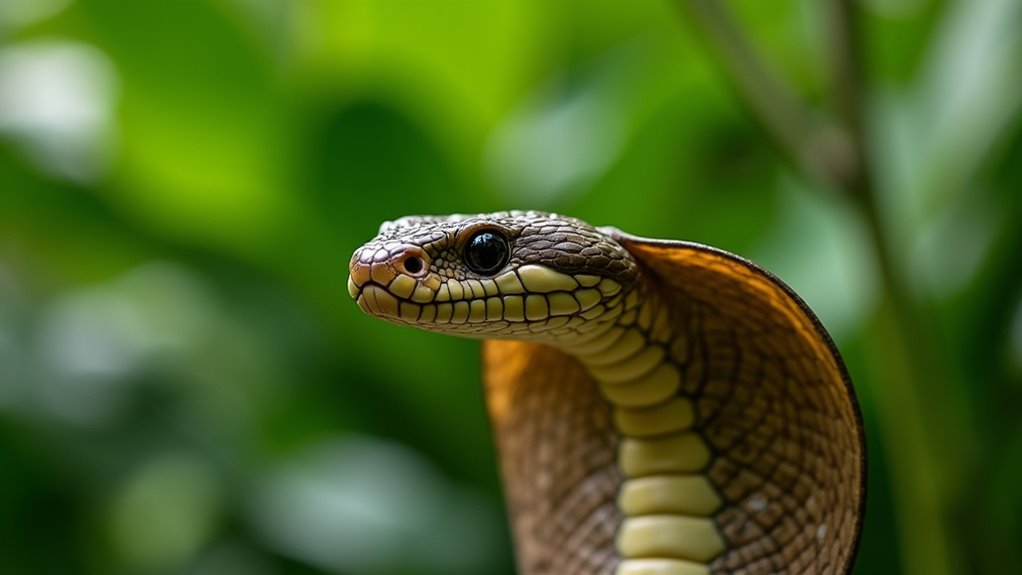
Lurking in diverse Philippines habitats, these nine lethal serpents pose deadly threats to unwary travelers who venture into their domain.
The Philippines hosts numerous dangerous venomous snakes including the highly toxic Philippine Cobra, aggressive Samar Cobra, and forest-dwelling South Philippine Temple Pit Viper. You’ll also find the Equatorial Spitting Cobra, Bornean Keeled Green Pit Viper, Yellow-lipped Sea Krait, Philippine Pit Viper, King Cobra, and Javan Spitting Cobra across various islands. These species inhabit diverse environments from forests to urban areas, making identification and avoidance essential for your safety during Philippine explorations.
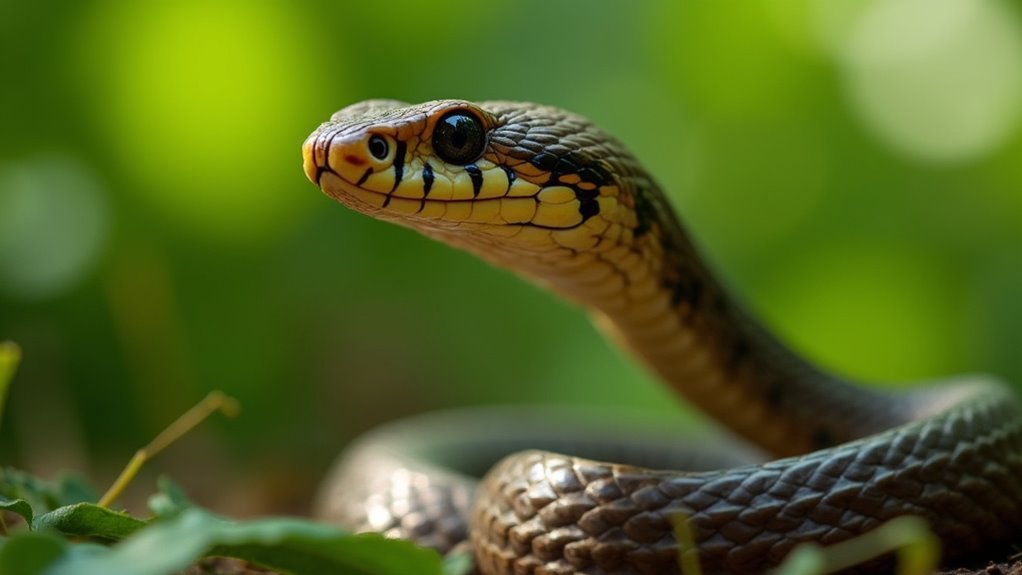
While many venomous snakes inhabit the Philippines, the Philippine Cobra distinguishes itself as one of the most notorious and dangerous serpents in the archipelago. You’ll find this deadly snake across Luzon, Mindoro, Catanduanes, and Masbate islands in various habitats from forests to urban areas.
Beware the Philippine Cobra—a deadly spitter lurking from forest trails to city streets throughout the island nation.
What makes this cobra particularly threatening is its ability to spit venom accurately at a distance, targeting your eyes as a defensive measure. The venom is highly toxic and potentially lethal.
If you’re exploring the Philippines, be cautious near water sources up to 800m above sea level where these snakes often reside. Though they’re more likely to flee than attack, their presence in agricultural fields and even urban settings means you should remain vigilant. It’s considered one of the deadly creatures that travelers should be aware of when visiting the country.
When bitten, victims typically experience rapid neurotoxicity with symptoms including headache, nausea, vomiting, and breathing difficulties that can lead to respiratory failure.
Specific antivenom may be limited in some regions.
Unlike its northern cousin, the Samar Cobra claims the southern Philippine islands as its territory, establishing a formidable presence throughout Visayas and Mindanao.
You’ll find this medium-sized cobra thriving in agricultural areas, where it hunts rodents, frogs, and small reptiles.
When threatened, it displays an intimidating hood and can accurately spit venom up to 3 meters.
Its venom contains potent alpha-neurotoxins that cause ptosis, respiratory distress, and potentially fatal cardiopulmonary arrest, while also producing severe local necrosis. Local tissue damage can lead to permanent disabilities, with long-term sequelae affecting three times more victims than deaths.
Unfortunately, no species-specific antivenom exists.
Treatment relies on PCAV (Philippine Cobra Antivenom), which cross-neutralizes weakly.
If bitten, seek immediate medical attention—and if venom contacts your eyes, irrigate thoroughly before rushing to a hospital.
Like many deadly animals in Laos, the Samar Cobra requires cautious interaction and respect from those who encounter it in the wild.
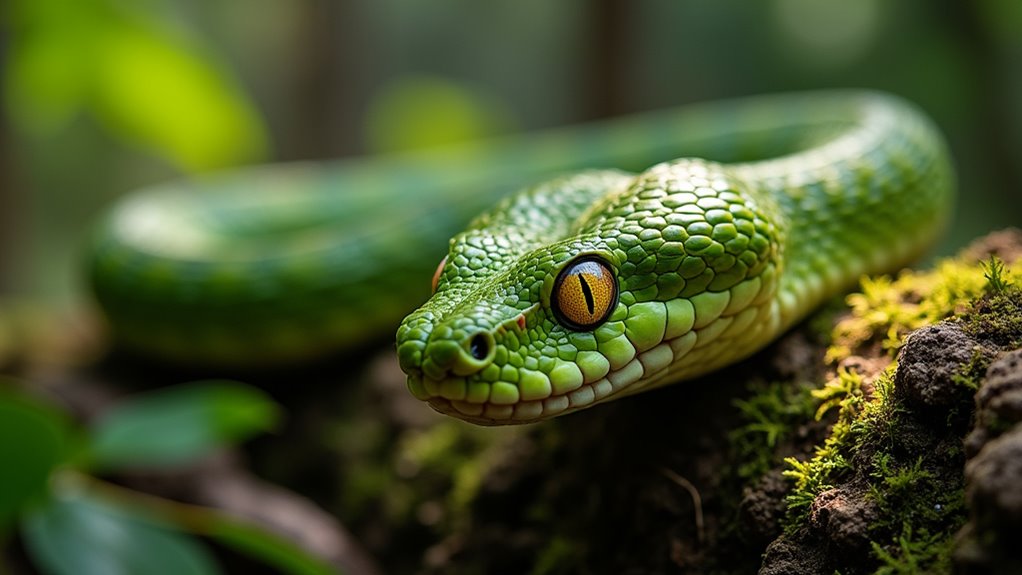
Hidden among the dense vegetation of western Mindanao lurks the South Philippine Temple Pit Viper (Tropidolaemus philippensis), a species that remains relatively unknown to many locals and visitors alike. This venomous serpent is endemic to the region and belongs to the deadly pit viper family.
While specific details about its venom aren’t extensively documented, you should treat it with extreme caution. Like most pit vipers, it possesses hemotoxic venom that can cause significant pain, swelling, and potentially serious medical complications. The species is classified under the Alethinophidia group of snakes according to taxonomic records.
Scientific data on the South Philippine Temple Pit Viper’s venom may be limited, but caution is paramount when encountering this potentially deadly serpent.
You’ll find these snakes are primarily nocturnal ambush predators, remaining docile during daylight hours but striking when threatened. Their ecological role includes controlling rodent populations in their habitat.
If you’re exploring western Mindanao’s forests, wear protective footwear and remain vigilant to avoid unwanted encounters with this hidden threat. Traveling in these regions is generally budget friendly compared to other Southeast Asian destinations, but always prioritize safety equipment when venturing into snake habitats.
Among the most feared serpents in the Philippine archipelago, the Equatorial Spitting Cobra (Naja sumatrana) prowls the lowlands of Palawan and the Calamian Islands with lethal precision.
Reaching lengths of 1.6 meters, these cobras adapt remarkably well to human environments, often hiding behind drains, garden walls, or household clutter.
You’ll find them more commonly in disturbed habitats and villages than in primary forests.
When threatened, they’ll rise up, expand their hood, and hiss loudly.
If this warning doesn’t deter you, they’ll project venom toward your eyes—potentially causing temporary or permanent blindness.
Though not typically aggressive, their highly toxic venom demands immediate medical attention if you’re bitten.
Their diet consists primarily of rodents and frogs, but they also consume small mammals, snakes, and lizards when available.
Like many deadly wildlife in Southeast Asia, these cobras represent a significant health risk to rural communities.
Always maintain awareness in cobra territory and seek prompt treatment for any encounters.
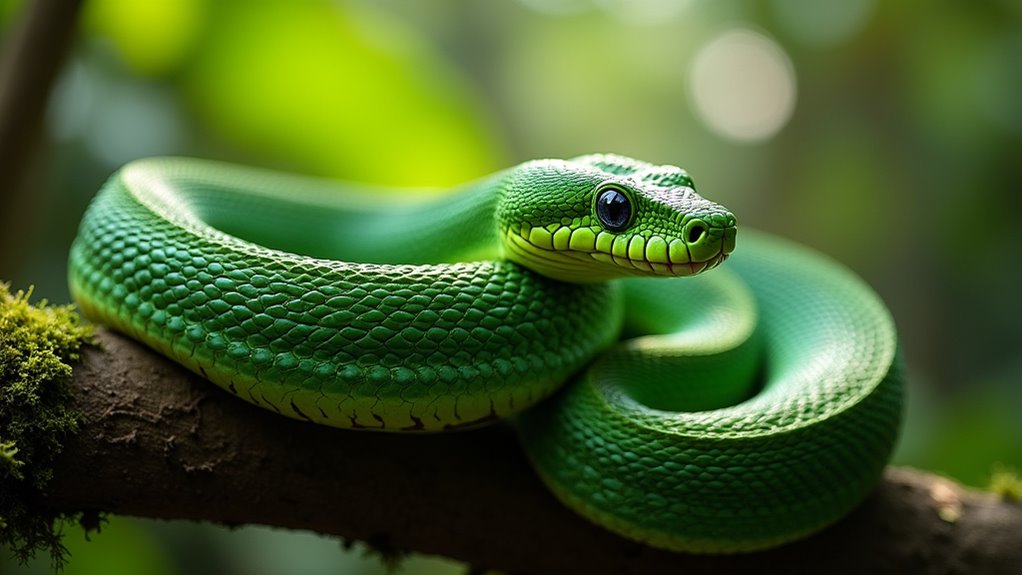
The emerald-scaled Bornean Keeled Green Pit Viper (Tropidolaemus subannulatus) thrives throughout the Philippine archipelago, from Luzon to Mindanao, including the Sulu islands and Palawan.
Recent discoveries have expanded its known range to include the Romblon Island Group.
Recent studies document the Bornean Keeled Green Pit Viper’s presence in the Romblon Island Group, extending its known Philippine distribution.
You’ll find this venomous snake in lowland primary forests and mature secondary forests, typically at low elevations.
Its distinctive keeled scales and pointed snout make it recognizable among the foliage where it hunts. The snake exhibits a bright green coloration with thin crossbands that provides excellent camouflage among the forest vegetation.
When travelers encounter these vipers during treks in Vietnam, especially in the northern regions around Hanoi, local guides emphasize extreme caution.
Don’t be fooled by its beauty—this ambush predator reaches lengths of 75-100cm and possesses hollow fangs for venom delivery.
Though generally not aggressive unless provoked, it poses a significant danger if encountered.
While classified as “least concern” conservation-wise, habitat loss threatens its forest canopy home.
While slithering through the waters of the Indo-Pacific region, the Yellow-Lipped Sea Krait (Laticauda colubrina) represents one of the Philippines’ most distinctive venomous reptiles. You’ll recognize it by its black-and-white banded pattern and signature yellow snout, adaptations that provide perfect camouflage among coral reefs.
Unlike many sea snakes, these creatures regularly return to shore to rest, digest prey, and lay eggs in rocky crevices. Their venom is considered extremely dangerous with an LD50 of 0.45 mg/kg in laboratory studies.
They’re primarily nocturnal hunters, specializing in eels and small fish with potent neurotoxic venom. Unlike the creepy crawlers that inhabit Philippine lands, these sea kraits represent aquatic predators that evolved specialized hunting techniques.
Despite their deadly bite, you’ll find them surprisingly docile and unlikely to attack unless provoked.
If you’re snorkeling Philippine reefs, you might spot one swimming with its paddle-shaped tail, but don’t worry – they’re more interested in finding their next meal than troubling human visitors.
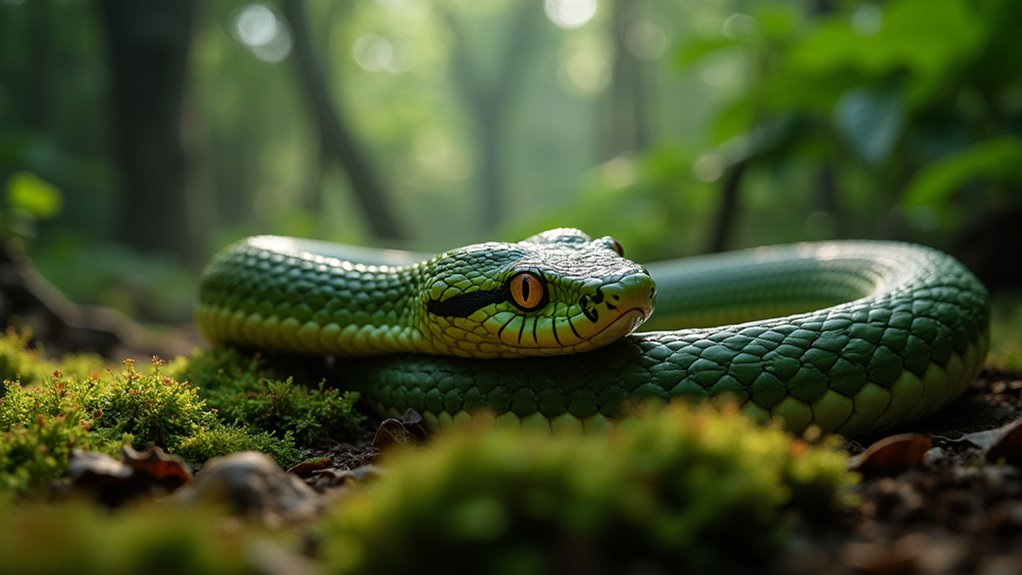
Moving from the ocean to the rainforest, you’ll find another deadly predator lurking in the Philippine wilderness. The Philippine Pit Viper is a highly venomous snake that’s mastered the art of camouflage across numerous islands including Luzon, Mindanao, and Negros.
You’ll typically spot these ambush predators on tree branches, where they patiently wait for unsuspecting prey. Their heat-sensing pit organs between the eyes and nostrils help them detect warm-blooded targets, especially at night when they’re most active. These snakes are primarily nocturnal hunters, which explains their excellent adaptation to low-light conditions.
Despite their deadly reputation, these snakes have adapted well to human-modified environments, thriving in plantations and forest edges up to 700 meters above sea level. These vipers represent just one of the many dangerous wildlife species that adventure travelers may encounter when exploring Asia’s natural landscapes.
While they’re not typically aggressive, you should exercise extreme caution—their venom delivers severe pain and can be fatal without prompt treatment.
Towering over most venomous serpents in Southeast Asia, the King Cobra reigns as an elusive giant in Philippine forests. This rare species, scientifically known as Ophiophagus hannah, can reach over 5 meters in length, making it the world’s longest venomous snake.
As nature’s lethal sovereign, the King Cobra dominates Philippine jungles with its imposing 5-meter frame and deadly neurotoxic arsenal.
You’ll find these majestic predators in western Visayas, particularly Cebu and Panay, inhabiting dense highland forests, mangrove wetlands, and agricultural boundaries.
Unlike their smaller cousin, the Philippine cobra, King Cobras possess potent neurotoxic venom that causes rapid paralysis and respiratory failure. Their venom primarily consists of three-finger toxins and snake venom metalloproteinases that target the nervous system.
When threatened, they’ll raise their body and spread their distinctive narrow hood.
These snake-eaters are most defensive during mating season (January-April) when guarding their nests—a unique behavior among snakes.
Habitat destruction threatens their vulnerable populations, making encounters extremely rare.
While these formidable serpents are found throughout Cambodia, they’re particularly prevalent in the dense forest regions between Phnom Penh and Siem Reap.
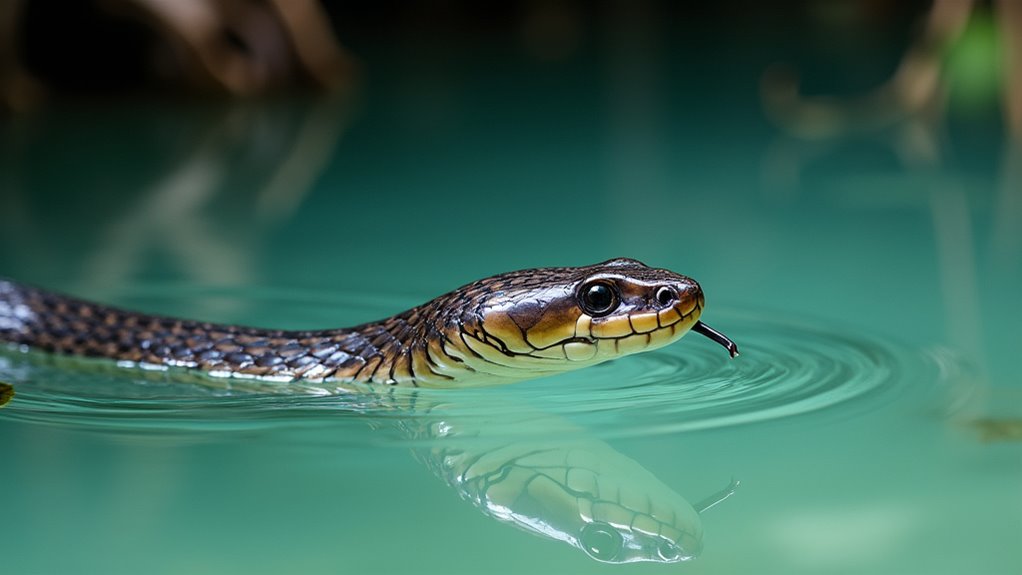
Among the many venomous serpents inhabiting the Philippines’ southern waters, the Javan Spitting Cobra distinguishes itself as a unique dual-threat predator. This adaptive species thrives in various ecosystems from tropical forests to cultivated areas, with its Philippine presence marking the northern limits of its range.
What makes this cobra particularly dangerous is its two-pronged attack capability. It can deliver venomous bites containing potent cytotoxins that cause severe tissue necrosis, or accurately spit venom at predators’ eyes from distances typical of spitting cobras (1.5-2.5 meters). The venom’s increased abundance of PLA₂ toxins enhances pain induction by activating nociceptors, making it an effective defensive deterrent.
Its venom (LD₅₀ of 0.90 mg/kg IV) combines cytotoxic cardiotoxins with neurotoxins that can cause respiratory distress.
The Javan Spitting Cobra breeds during the dry season, laying clutches of 13-19 eggs with an 88-day incubation period. Travelers should exercise extreme caution when exploring the southern Philippines, as encounters with these dangerous serpents can significantly impact vacation safety.
You’ve now learned about the Philippines’ most dangerous serpents. While these venomous species are concerning, remember that fatal snake bites are rare, with only about 1-2 deaths per 100,000 people annually in the country. That’s lower than many other Southeast Asian nations. If you’re exploring Philippine wilderness, wear proper footwear, watch your step, and keep a healthy distance when spotting these remarkable but potentially deadly creatures.